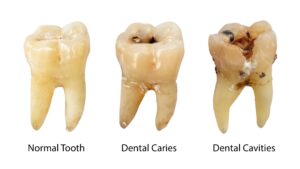 Your child’s baby teeth are essential for their development. Losing a baby tooth too soon can affect their oral health and development negatively. The biggest threat to their dental health is tooth decay. Cavities are more common than childhood asthma, diabetes, and obesity. 21% of children between the ages of 2 and 5 have cavities and 51% of children aged 6-11 have tooth decay. White dental fillings are the go-to solution to treat decay. Unfortunately, cavities aren’t always visible. Although only a dentist can determine if your little one needs a dental filling, here’s how to spot the signs of tooth decay.
Your child’s baby teeth are essential for their development. Losing a baby tooth too soon can affect their oral health and development negatively. The biggest threat to their dental health is tooth decay. Cavities are more common than childhood asthma, diabetes, and obesity. 21% of children between the ages of 2 and 5 have cavities and 51% of children aged 6-11 have tooth decay. White dental fillings are the go-to solution to treat decay. Unfortunately, cavities aren’t always visible. Although only a dentist can determine if your little one needs a dental filling, here’s how to spot the signs of tooth decay.
Common Symptoms of Tooth Decay
Cavities can cause several symptoms, including toothaches and sensitivity. However, those aren’t the only signs of a problem. Your child may also experience:
- A sharp or throbbing pain
- A fracture
- Roughened tooth surface
- Floss fraying
- Food getting stuck in certain teeth
- Dark spot on a tooth
If you suspect tooth decay, don’t wait until your child’s next cleaning and checkup to see a dentist. With no treatment, their tooth can become infected. A filling will no longer be an option. Instead, they’ll need a root canal.
What to Expect with Dental Fillings
Their dentist will examine their mouth and review an X-ray to diagnose decay. Early stages of decay can be treated with a tooth-colored filling. Their dentist will use numbing medication to keep your little one comfortable as they remove decay. They’ll use a composite resin material to fill the cavity. Unlike traditional amalgam fillings, composite materials are metal and mercury-free. Not to mention, the resin can be matched to the color of the tooth to blend in.
After any prep work, their dentist will apply a weak acid to open the pores in your child’s enamel. This creates a strong bonding surface, so wedges aren’t cut into their tooth to support the filling, like with metal materials. They’ll maintain more of their healthy tooth structure.
Their dentist will rinse and dry their tooth before applying the resin, which will be shaded to their enamel color. After the resin is molded into the desired shape, they’ll use a special dental light to harden it in a matter of a few seconds. Finally, their pediatric dentist will check their bite to ensure no adjustments are needed. They’ll smooth and polish their tooth to ensure the best aesthetic results.
You can protect your child’s smile from cavities with good oral hygiene habits at home. Limit sugars and starches, which feed cavity-causing bacteria. Schedule a cleaning and checkup every 6 months to keep their teeth and gums healthy.
About Dr. Sheh Vahid
Dr. Vahid earned her dental degree at the University of Pennsylvania School of Dental Medicine and has continued her training to become a board-certified pediatric dentist. She is a member of several professional organizations, including the American Academy of Pediatric Dentistry. Request an appointment through her website or call her office at (678) 304-1994.
